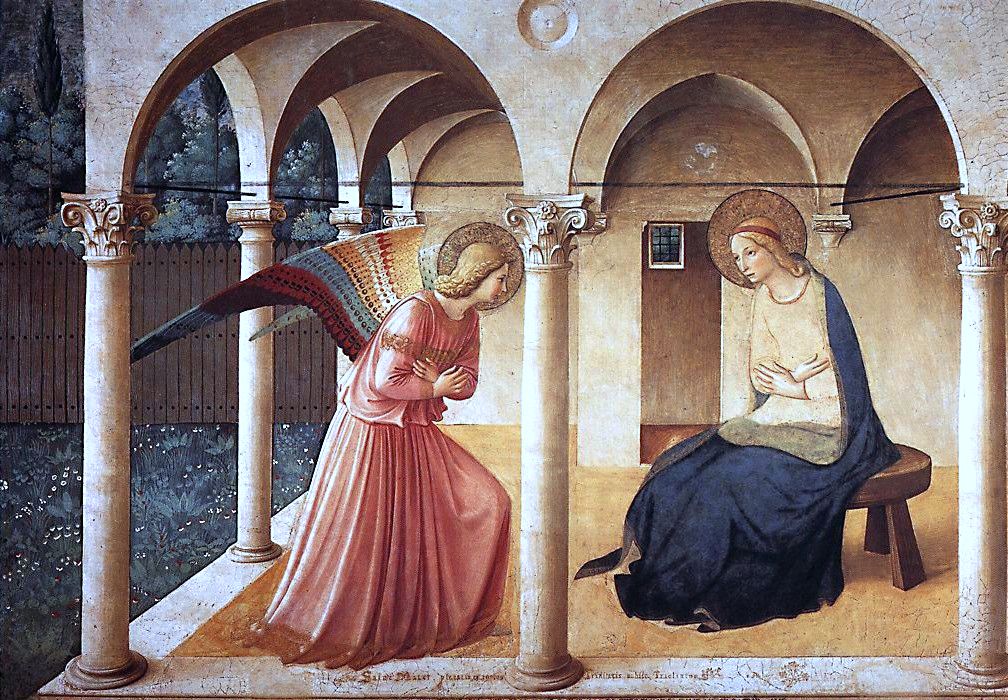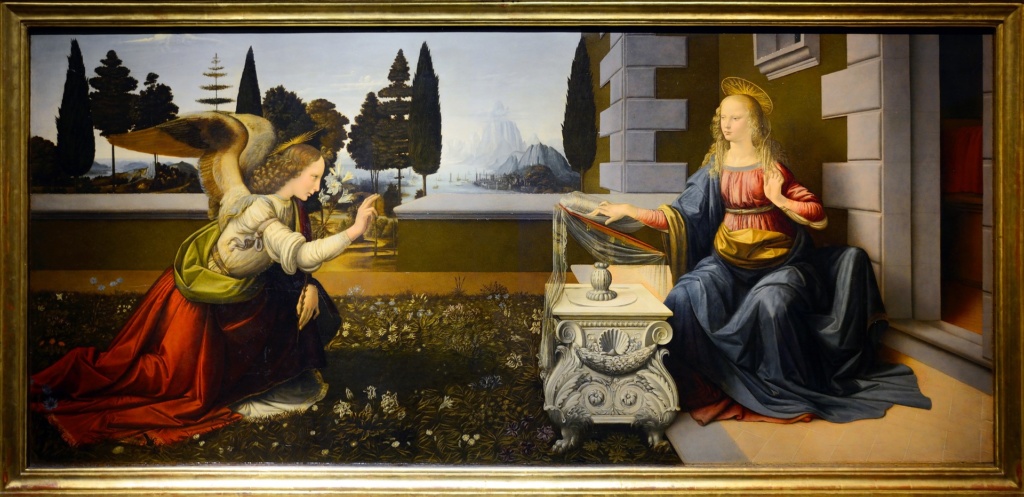Back to: Renaissance Art and the Christmas Story
Fra Angelico – “The Annunciation” (c. 1437-1446)

Fra Angelico was a fresco painter. Fresco is Italian for “fresh” in which color pigments are mixed solely with water (no binding agent used) and then applied directly onto freshly laid lime-plaster ground (surface). (Oil painting, a product of the Renaissance, would come later.)
The surface is typically a plastered wall or ceiling. The liquid paint is absorbed by the plaster and as the plaster dries the pigments are retained in the wall. Before paint was applied, the artist usually made a preparatory drawing (sinopia) in red chalk.
He gained work in the 1440’s with the renovation of San Marco convent in Florence financed by the Medici family. It involved the church, living quarters and library – by the architect Michelozzo di Bartolomeo, and the opening of the first public library since antiquity. The commission to Fra Angelico included the convent’s altarpiece together with more than fifty other frescoes.
The Annunciation was one of the last San Marco frescoes to be completed and was painted on Angelico’s return from Rome in 1450. It shows Gabriel and the Virgin conversing in a cloister fringed with Corinthian columns. The Feast of the Annunciation, one of the principal feasts of the Christian church, is celebrated on March 25 (Lady Day), nine months before Christmas.
Mary is pictured seated within the cloister, which underlines her separateness from the world. Gabriel visits Mary in an outdoor setting in contrast to earlier Gothic paintings which usually placed her inside. The use of spacing and light were unique. Perspective was relatively new, and there are several levels between Mary and Gabriel and the individuals behind.
The Annunciation is the angel Gabriel’s pronouncement of the birth of Christ. It is met with Mary’s willing consent (“Here am I, the servant of the Lord; let it be with me according to your word”), and thus leads to the Incarnation of Christ, God taking a human body
The picture perfectly expresses the feeling of veneration on the part of Gabriel, as well as the submissive humility of the Madonna, while the gentle nature of the scene is reflected in the curves of both the figures and the architecture.
It is a spare image that fits the convent and allows the monks to fill In the story for themselves. For instance, there are there are no white lilies, a Bible being opened.
Although the picture indicates good control of linear perspective, its lighting is rather inconsistent. Mary casts a shadow, but Gabriel does not – perhaps because he is a messenger of God. In addition, the interior of the arcade is evenly lit throughout, despite the natural daylight coming from the left.
This is a transition painting – flatness on the left (forest) and the column with no shadows and more perspective on the right (Mary) though the figures are too large for the space. The wings are set to capture the light
Leonardo da Vinci – “The Annunciation” (c. 1472-1475)

Leonardo da Vinci (1452-1519), Florentine artist, is one of the great masters of the High Renaissance, celebrated as a painter, sculptor, architect, engineer, and scientist. His profound love of knowledge and research was the keynote of both his artistic and scientific endeavors. His innovations in the field of painting influenced the course of Italian art for more than a century after his death, and his scientific studies—particularly in the fields of anatomy, optics, and hydraulics—anticipated many of the developments of modern science.
Leonardo began his life in 1452 as the illegitimate son of Piero da Vinci, who brought him to live in Florence.
Although Leonardo da Vinci produced a relatively small number of paintings, many of which remained unfinished, he was nevertheless an extraordinarily innovative and influential artist. During his early years, his style closely paralleled that of Verrocchio, but he gradually moved away from his teacher’s stiff, tight, and somewhat rigid treatment of figures to develop a more evocative and atmospheric handling of composition.
The Annunciation was executed around 1472-1475, when Leonardo was still an apprentice in the workshop of his master, Andrea del Verrocchio.
This painting shows a flourishing enclosed garden, in front of a Renaissance palace and evokes the purity of Mary. Archangel Gabriel kneels before the Virgin, proffering a lily, a symbol for purity. The archangel Gabriel is kneeling as a dignified profile figure and raising his right hand in greeting to Mary, indicating her divine pregnancy.
The Virgin Mary is sitting down in front of a book stand or small altar, which is decorated with classical motifs that seem very much influenced by Verrocchio. The Virgin responds from her dignified seat, behind a lectern, at which she was reading. She has stopped reading and reacts to the Annunciation with an expression of deep respect and by gesturing with her left hand. The traditional religious theme has been set by Leonardo in an earthly, natural setting and typical of Renaissance Art. This is a much more detailed work than the one by Fra Angelico.
The angel has a solid body suggested by his shadow on the grass, and the folds of his clothing, which would seem to show studies from real life. His wings too are based on those of a mighty bird of prey. They are not multicolor which was the tradition at the time. This is also a break with tradition. A sun ray shapes the forms, brings the scene together, and emphasizes the dark tree shapes in the distant background, dominated by the blended colors much loved by the artist. The architectural features are drawn according to the rules of perspective, with a central vanishing point
With one of his hands the angel is offering Mary a lily, a symbol of purity and with the other is giving a blessing. Mary acquiesces to his request while one of her hands is resting across a book on beautiful lectern. Behind Mary is a bedroom which can be glimpsed.
This painting breaks with the past on the annunciation. Earlier versions were in a closed or half-closed setting. This one is in open air. The wings are original and seem to be like a bird of prey. They are not multicolor which was the tradition at the time. This is also a break with tradition. The garden is diverse with many types of flowers.
The aerial perspective is another Leonardo innovation. He also used a sfumato technique allowing tones and colors to shade gradually into one another creating softened or hazy outlines. We can see this is in the background where the colors are pale and blurred in contrast to the objects in the foreground that are depicted carefully. It was not unusual for artists to depict themselves in paintings but in this case, the handprints to the right are Leonardo’s hands. See Mary’s right hand.
What is the importance of this painting?
1. The Adoration of the Magi introduced a new approach to composition, in which the main figures are grouped in the foreground, while the background consists of distant views of imaginary ruins and battle scenes.
The sacred scene is set in the garden of a Florentine palace, with a landscape on the background which is already peculiarly Leonardesque, for the magic and unreal atmosphere created by mountains, water and sky.
In the background, there is a river with boats, mountains and trees. The line of cypress helps to physically divide the backdrop
The work is meant to be seen from below and from the right. From this point of view certain details come into proper alignment such as the keystones on the building, the foreshortening of the Virgin’s arm and the lectern.
2, Leonardo’s personality is pointed out also in the beautiful drapery of the Virgin and the Angel, while the marble table in front of her probably quotes the tomb of Piero and Giovanni dei Medici in the church of San Lorenzo sculpted by Verrocchio in this period.
3 Leonardo featured interactions between characters – In his drawings, Leonardo rendered the multiple positions of his figures in an attempt to capture their physical and emotional interactions.
Her head clearly contrasts with the dark wall and her body is emphatically framed by the cornerstones whose parallel lines are converging on her.
The painting of Mary is in her three-quarter form sitting on a chair outside a room. The height, width and depth of the painting all meet in Mary’s spot and with Mary’s body outlined by the house’s cornerstones and her head emphasized by the dark wall. The technique emphasized Mary’s importance is signified in the painting and gave it a sense of depth.
There is a conspicuous perspective mistake: her right arm had to be painted too long proportionally, so that, despite her seated position, it would still be able to depict the impressive position other hand over the priedieu.
Leonardo’s interest in anatomy allowed him to paint figures with amazingly accurate details in their forms and proportions
